Physical Address
304 North Cardinal St.
Dorchester Center, MA 02124
Imaging plays an integral role in detection, grading, and management of iAVMs.
Intracranial hemorrhage in a young patient should raise suspicion of an underlying iAVM.
CT angiography is 90% sensitive in the detection of iAVMs.
4D contrast-enhanced MR angiography at 3.0 T has 100% agreement with digital subtraction angiography (DSA) in its ability to diagnose and classify untreated iAVMs with regard to Spetzler-Martin classification.
Although innovative noninvasive imaging can now be used to follow treated iAVMs, DSA remains the diagnostic gold standard.
Imaging plays a critical role in detecting, grading, and managing intracranial arteriovenous malformations (iAVMs). Key imaging features include size, relationship to eloquent brain, presence of deep venous drainage, presence of hemorrhage, and compactness of the nidus; these elements assist in accurately grading the AVM utilizing the Spetzler-Martin AVM and supplemental Lawton-Young grading systems ( Table 3.1 ). Introduced in 1986, the Spetzler-Martin grade serves as a tool to estimate surgical risk. The initial grading system included five grades (I–V), with higher grades corresponding to greater surgical risk. It was subsequently simplified to a three-tiered system: class A (formerly grades I and II), class B (formerly grade III), and class C (formerly grades IV and V). The AVM nidus is classified as small (< 3 cm), medium (3–6 cm), or large (> 6 cm) in size and, respectively, assigned 1, 2, or 3 points, based on its maximum diameter. “Micro” AVMs are those with a nidus less than 1 cm in size, typically with normal-size feeding arteries and draining veins and are classically syndromic in etiology (i.e., associated with syndromes such as hereditary hemorrhagic telangiectasia).
| Variable | Parameter | Points |
|---|---|---|
| Spetzler-Martin Grading (Max Total Score: 5) | ||
| Size, cm | < 3 | 1 |
| 3–6 | 2 | |
| > 6 | 3 | |
| Venous drainage | Superficial (cortical veins and convexity) | 0 |
| Deep (vein of Galen) | 1 | |
| Eloquence | No | 0 |
| Yes (sensorimotor, language and visual cortices; thalamus and hypothalamus; internal capsule; brainstem; cerebellar peduncles and deep cerebellar nuclei) | 1 | |
| Lawton-Young Grading (Max Total Score: 5) | ||
| Age, years | < 20 | 1 |
| 20–40 | 2 | |
| > 40 | 3 | |
| Bleeding | Yes | 0 |
| No | 1 | |
| Compactness | Yes | 0 |
| No | 1 | |
Intracranial AVMs (iAVMs) have been further classified based on location, with seven defined sites: frontal, temporal, parietooccipital, intraventricular, deep central core, brainstem, and cerebellum. Each location is characterized by its arterial supply, draining veins, and associated eloquent structures, as well as its specific surgical approach and management. The vast majority of iAVMs (approximately 85%) are supratentorial in location. Only 15% are located within the posterior fossa.
Involvement of eloquent brain, considered an area resulting in a disabling neurologic deficit if injured (e.g., sensorimotor, language, and visual cortices; thalamus and hypothalamus; internal capsule; insula; brainstem; cerebellar peduncles and deep cerebellar nuclei), confers an additional point in the Spetzler-Martin grading system, as does the presence of deep venous drainage. Functional imaging, discussed in Chapter 4 , is helpful to determine the involvement of eloquent brain. Imaging can also be integral in identifying morphologic features associated with increased risk of future rupture and hemorrhage (initial hemorrhagic presentation, > 3 cm in size, associated flow-related or intranidal arterial aneurysms, deep brain location, periventricular/intraventricular location, deep venous drainage, venous varices, outflow venous stenosis, or presence of a single draining vein), discussed in Chapter 39 . The present chapter reviews the radiographic anatomy and multimodal imaging approach for iAVMs with a focus on CT, MRI, and conventional digital subtraction angiography (DSA).
An AVM is a complex network of abnormal vascular channels consisting of three distinct components: arterial feeder(s), a central nidus, and draining vein(s) ( Fig. 3.1 ). Intracranial AVMs often resemble a “bag of worms,” formed by a tightly packed tangle of serpiginous thin-walled vessels without an intervening capillary bed and with little or no mass effect upon the adjacent brain. Diagnostic criteria for AVMs include the presence of a nidus as well as early venous drainage, best seen in dynamic studies. All three AVM components must be thoroughly evaluated, as each is associated with important features that may impact clinical management.
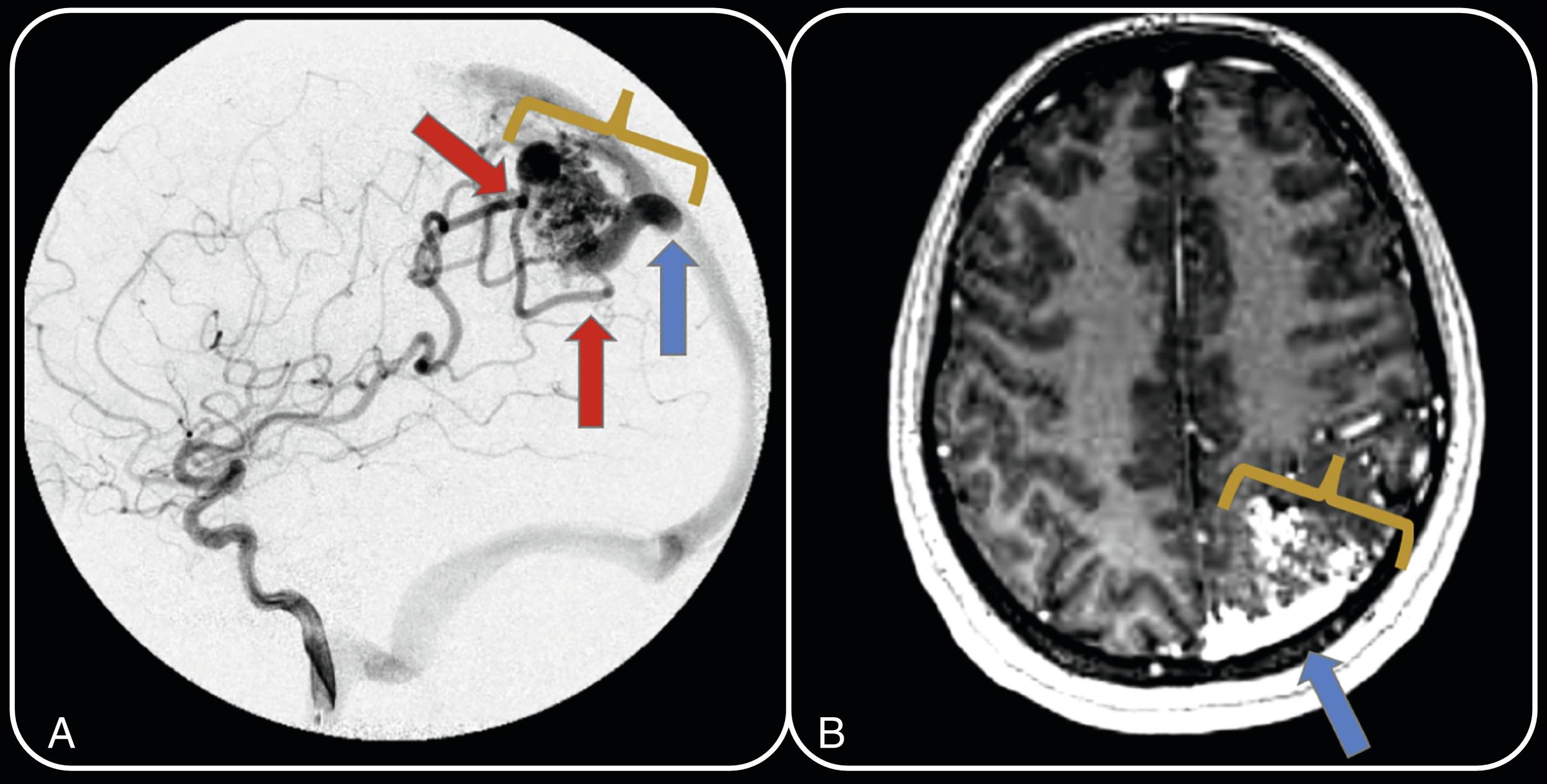
Identification of the number, location, and type of feeding arterial branches is important for determining optimal management. Arterial feeders are classified as pial (i.e., superficial/cortical) or perforator (i.e., deep) in type. While the vast majority of iAVMs are the pial type, AVMs in deep or ventricular locations will recruit arterial supply from the perforator (lenticulostriate/thalamoperforator branches) and/or choroidal (anterior, medial, and lateral posterior) arteries. Arterial feeders are often enlarged and tortuous, with the degree of dilatation dependent upon shunt volume. Flow-related angiopathy, ranging from simple dilatation through endothelial thickening to stenosis or even occlusion, may be present.
Complications associated with arterial feeders include arterial aneurysms, which are classified as intranidal (situated within the nidus; Fig. 3.2 ), flow-related (involving AVM feeding arteries in a location proximal to the nidus and therefore may regress upon AVM treatment), or unrelated (do not supply AVM and are likely coincidental). The presence of intranidal or feeder aneurysms is thought to indicate high AVM inflow and is considered a predictor of hemorrhage. Approximately 25% of iAVMs may have transdural arterial contributions; therefore a thorough evaluation of the dural vasculature should be included in the complete angiographic delineation of AVM arterial supply.

The nidus of the iAVM is the conglomeration of abnormal tortuous vascular channels, often interspersed with nonfunctional gliotic tissue. As the nidus lacks a capillary bed, blood from supplying arteries is shunted directly into the draining vein(s) ( Figs. 3.1–3.3 ). Intranidal vascular components may range from well-differentiated arteries and veins to dysplastic vascular channels of varying diameters and wall thickening, histologically neither artery nor vein. Intranidal aneurysms have been reported to occur in up to 50% of iAVMs. Nidal compactness is an additional prognostic feature, included in the Lawton-Young grading scale ( Table 3.1 ). Compact iAVMs have distinct borders and contain tightly woven arteries that separate cleanly from adjacent parenchyma, whereas diffuse iAVMs have ragged margins and are intermixed with parenchyma.
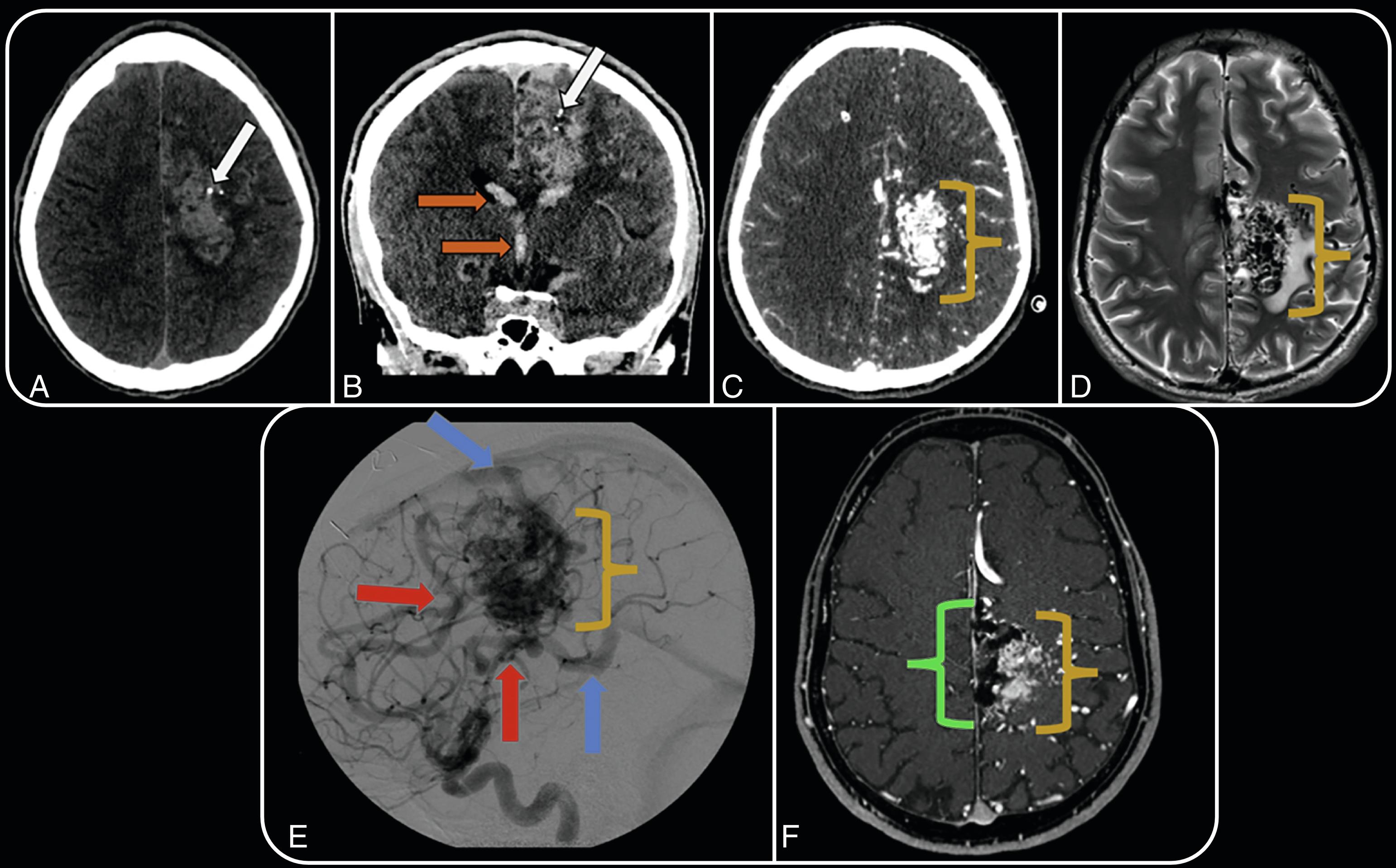
The presence and compactness of a discrete nidus with intervening gliotic parenchyma distinguishes a classic iAVM from other cerebrovascular malformations, such as a pure arterial malformation, venous-predominant AVM, proliferative-type AVM, cerebral proliferative angiopathy (CPA), pial arteriovenous fistula (AVF), or dural AVF. Fig. 3.4 illustrates a diagnostic approach to cerebrovascular malformations based on the imaging characteristics of the nidus as well as the presence of enlarged pial arteries. Pure arterial malformation, a newly recognized entity, is defined as dilated overlapping and tortuous arteries with a coil-like appearance and/or mass of arterial loop without an associated nidus or venous component ( Fig. 3.5 ). They are rare lesions, typically detected incidentally and with a benign natural history. Another incompletely understood lesion, characterized by early contrast filling of dilated branching medullary veins draining into a dominant vein in the absence of a nidus, has been referred to as a venous-predominant AVM; these lesions can mimic the common benign developmental venous anomaly (DVA) but are distinguished by the presence of arteriovenous shunting. CPA, formerly known as diffuse nidus type AVM, is a vascular malformation characterized by the presence of normal parenchyma interspersed throughout its nidus. CPA is distinguished from proliferative-type AVM by its absence of an early venous drainage. Additional characteristic features of CPA include large areas of parenchymal involvement (e.g., lobar or hemispheric), a nidus fed by multiple arteries in the absence of a dominant feeder, normal to only modestly enlarged feeder arteries, and associated stenosis of feeder arteries. On angiography, CPA is also characterized by “puddling” of contrast involving the nidus, which persists into the late arterial and early venous phases ( Fig. 3.6 ). A pial AVF is a rare lesion composed of a direct arteriovenous connection in the subpial space without an intervening nidus ( Fig. 3.5 ), whereas a dural AVF is an abnormal arteriovenous connection that occurs within the dura mater, most frequently involving the dural venous sinuses.
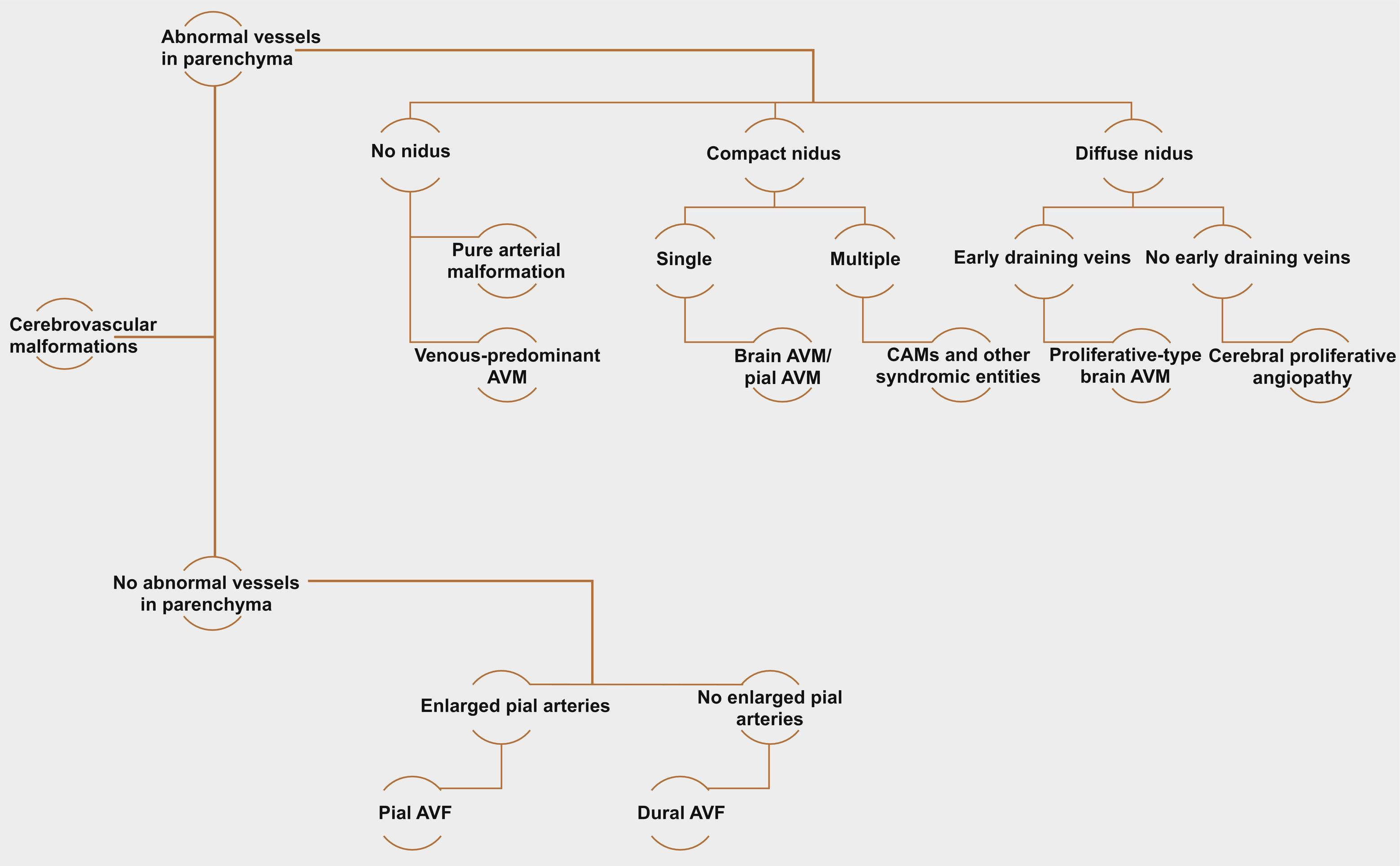
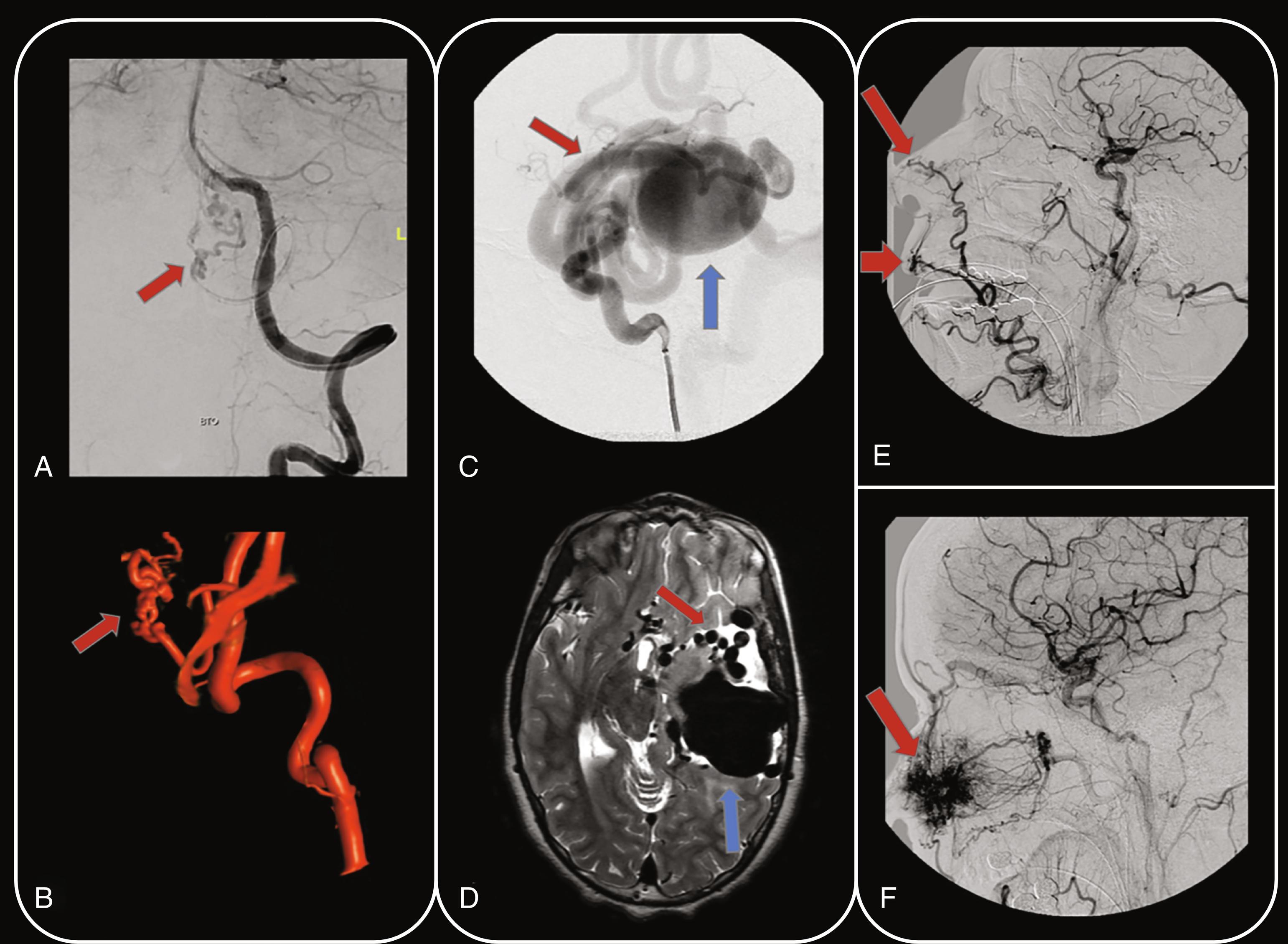
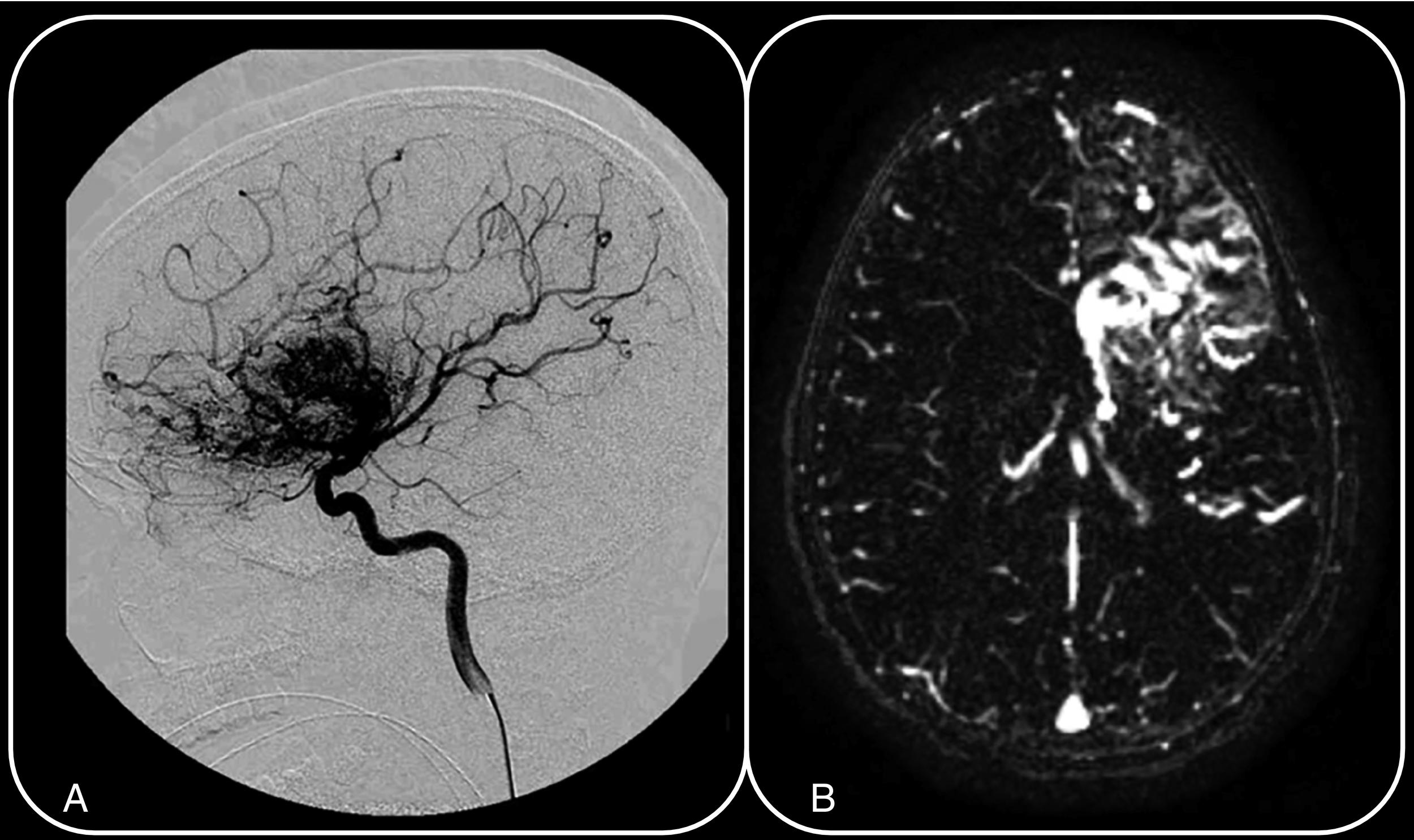
The presence of multiple classic iAVMs may be indicative of an underlying syndrome, such as hereditary hemorrhagic telangiectasia or cerebrofacial arteriovenous metameric syndrome (CAMS). CAMS, also known as Wyburn-Mason syndrome or Bonnet-Dechaume-Blanc disease, is a segmental neurovascular syndrome with three forms—CAMS type I, involving the medial prosencephalon, with AVMs located at the corpus callosum, hypothalamus, and nose; CAMS type II, involving the lateral prosencephalon, with AVMs located at the occipital lobe, optic chiasm, optic tract, thalamus, retina, and maxilla; and CAMS type III, involving the rhombencephalon, with AVMs located at the cerebellum, pons, and medulla.
Become a Clinical Tree membership for Full access and enjoy Unlimited articles
If you are a member. Log in here